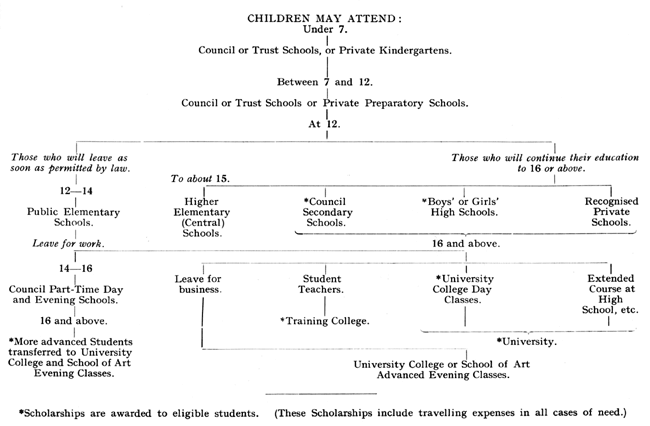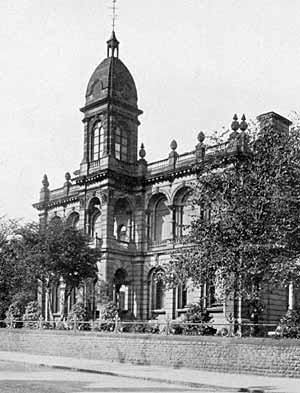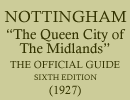EDUCATION.
The high quality of the labour available in Nottingham is due in a considerable measure to the exceptional educational facilities afforded by the city, which has done great things for employers by its judicious expenditure on technical education and its School of Art. The future life-work of the children coming under the care of the Education Committee is prepared for from the very beginning. In the 73 Elementary and Central Schools, and in the two Secondary Schools, where the fees, for children of ratepayers, are only £6 a year, including free use of books and apparatus, special attention is given to the practical side of education, thus preparing the coming generation in each year for industrial life, and giving an invaluable groundwork in deftness of hand and quickness of eye.
The Nottingham Girls' High School, established by the Girls' Public Day School Trust, provides accommodation for 280 pupils.
Special Handicraft centres provide accommodation for a larger number of boys every year. Those for whom places cannot be found in the special centres, are taught a form of light woodwork in their respective schools with the object of cultivating a spirit of enquiry and observation. Practical lessons in home training, personal hygiene, and care of the infant, are given to a large proportion of the girls in elementary and secondary schools. Modern methods of teaching needlework, carefully adapted to home requirements, have also been introduced. Organized play, swimming and life-saving, and general athletics receive special attention.
In cases of poverty, the school children are fed at specially-equipped canteen centres. An open-air school has been put up in the Arboretum for the recuperative treatment of weakly children, and the Public Offices in Nottingham Road have been converted into a school for children who are mentally deficient. Medical inspection and treatment of school children is carried on as a matter of school routine, according to the regulations of the Board of Education. Through their Juvenile Employment Department the Committee ensure that employers shall have the opportunity of interviewing suitable applicants for the vacancies on their staffs which are to be filled by boys and girls between the ages of 14 and 18 years.
Scholarships tenable at the two secondary schools of the Council and at the boys' and girls' high schools are open to all scholars in the public elementary schools who pass the necessary qualifying examinations, and scholarships and bursaries tenable at Nottingham University College and Municipal School of Art enable eligible boys and girls in the Council secondary schools to pass on to higher University and technical training.
It will be obvious that the provision of these special facilities, making it possible for any child to make his or her way, not only to the University College of Nottingham, but to other University institutions, must stimulate endeavour, and thereby react upon the general standard of intelligence.
The table below shows the various grades of schools in the City either under the control of, or working in association with, the Education Committee; and also the courses of instruction, extending from the Infant Kindergarten to the University, which is now open, free of cost, to Nottingham scholars of special promise.

THE UNIVERSITY COLLEGE.

The School of Art.
The foundation stone of University College, in Shakespeare Street, was laid on September 27th, 1877, by the Mayor, Alderman J. W. Bowers. The College was opened on the 30th June, 1881, by his Royal Highness the Duke of Albany, and the first session began on 1st October, 1881. All provision for Higher Education of adults was gathered into the College, and facilities for day and evening studies were afforded to all without distinction. The College was affiliated in 1883 to the Universities of Oxford and Cambridge. It was governed from the outset by a Committee of the Town Council until 1903. On the 27th August of that year a Royal Charter of Incorporation was granted, vesting the College in a Court of Governors consisting of the City Council, with a President and Vice-President elected by them.
The present Technical Schools were opened on the 12th January, 1893, by the Master and Wardens of the Drapers' Company of the City of London.
The College prepared for Degrees of the University of London and for Diplomas in Commerce, Social Study, Geography, Chemistry, Pharmacy, Physics, Education (Elementary and Secondary), Engineering, Mining and Mine Surveying, Hosiery Manufacture, and Dyeing and Finishing. It is divided into four Faculties:— The Faculty of Arts, including the Departments of English, History, Classics and Philosophy, Modern Languages, Education, Extra Mural Education, and Music; the Faculty of Economics and Commerce, including the Departments of Law and Social Study, and Medicine; the Faculty of Pure Science, including the Departments of Chemistry, Metrology, Physics, Mathematics, Biology and Bacteriology, Geology, Geography; and the Faculty of Applied Science, including the Departments of Engineering, Technology, Mining and Textiles.
There are four Halls of Residence connected with the College: Mapperley Hall and Waverley House for men, Cavendish House and Hollygirt for women.
During the session 1925-6 there were 729 day students and 2,038 evening students in attendance.
The social side of the College is in the hands of the Students' "Union," which has the control of all Clubs and Societies. The Tennis Ground, with ten courts, is situated in Elm Avenue, and the Athletic Ground in University Park, where provision is made for cricket, hockey, netball, tennis, and football (Rugby and Association).
Full information as to classes, fees, etc., is contained in the prospectus issued annually in September, which can be obtained on application to the Registrar. Negotiations are at present in progress for obtaining a Charter for a full University. (See advertisement on map facing page A20.)
New University Buildings are now nearing completion in University Park at a cost of £350,000. This has been made possible by the great generosity of Sir Jesse Boot, Bart., who has not only provided the site and very large sum towards the cost of the buildings, but has given to the City, and laid out at a cost of hundreds of thousands of pounds, the Park itself, which provides a beautiful setting for the new buildings. (See pages 37 & 63).

H.R.H. PRINCESS MARY VISCOUNTESS LASCELLES, viewing the New University Buildings on her visit to Nottingham, 30th April, 1927.
